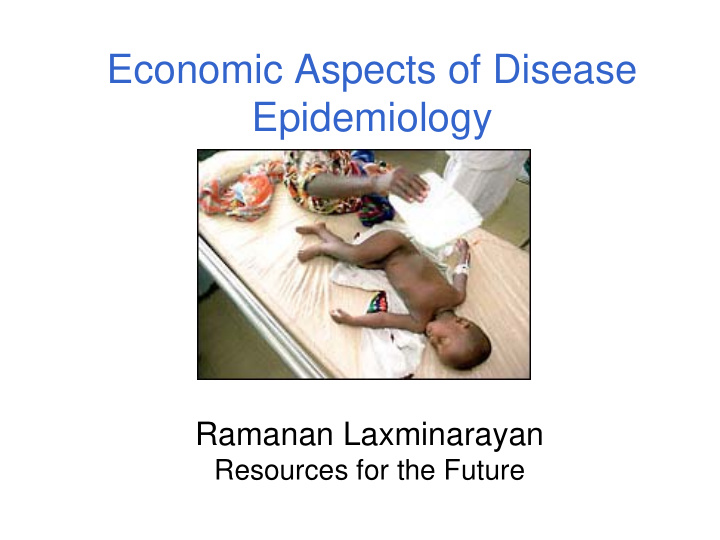



Economic Aspects of Disease Epidemiology Ramanan Laxminarayan Resources for the Future
Economic Epidemiology Mathematical conceptualization of the interplay between economics, human behavior and disease ecology to improve our understanding of – the emergence, persistence and spread of infectious agents – optimal strategies and policies to control their spread
Overview � Individual response and disease � Incentives of institutions (to invest in hospital infection control) � Malaria subsidy
Individual response and disease � Vaccinations – Insufficient incentives to vaccinate prevent attainment of herd immunity thresholds � Drug resistance – Insufficient incentives to make appropriate use leads to ineffective drugs and increasing prevalence � Testing – Private testing behavior adds to public information on disease prevalence
Rational epidemics � Prevalence response elasticity – Hazard rate into infection of susceptibles is a decreasing function of prevalence (opposite of epidemiological model predictions) – Application to HIV – Application to Measles
Geoffard and Philipson, Int. Econ. Rev., 1996
Blower et al, Science, 2000
Blower et al, Science, 2000
When should governments intervene? � Disease prevalence increases adoption of public programs � Impact of public program may be zero if prevalence has already reached an individual’s threshold prevalence � Paradoxically, the role of government subsidies is lowest when prevalence is highest since individuals will protect themselves regardless
Philipson, NBER, 1999
Public price subsidies � Can price subsidies or mandatory programs achieve eradication? – Increase in demand by folks covered by the program lowers the incentives to vaccinate for those outside the program � Do monopolistic vaccine manufacturers have an incentive to eradicate disease? – Market for their product would disappear with eradication Geoffard and Philipson, Int Econ Rev, 1997
Disease Complementarities � Incentive to invest in prevention against one cause of death depends positively on probability of dying from other causes � Intervening to prevent mortality not only prevents a death but also increases incentives for the family to fight other diseases
Dow et al, Am Econ Rev, 1999
Does the theory fit the facts? � Do individuals actually observe prevalence? � Why don’t we see prevalence responsiveness at work everywhere? � Importance of observational learning (herd behavior)?
Stoneburner and Low-Beer, Science, 2004
Stoneburner and Low-Beer, Science, 2004
Stoneburner and Low-Beer, Science, 2004
60 Years Later
NNIS Data, 2004
Optimal infection control Infection dynamics are given by ̇ c X 1 − X − X − X Equilibrium prevalence is given by S c − 1 S c − 1 2 4 S c ̄ c X 2 S c Smith, Levin, Laxminarayan (PNAS, 2005)
Objective Minimize costs of infection control and infections ̄ c c DX Local minima, if they exist, are solutions to ̄ ′ c 0 1 DX Smith, Levin, Laxminarayan (PNAS, 2005)
Smith, Levin, Laxminarayan (PNAS, 2005)
Implications for policy � Dutch experience: frequency of MRSA infections is < 0.5% after an intensive ‘‘search-and-destroy’’ campaign, compared with 50% in some areas � In Siouxland (Iowa, Nebraska, S. Dakota), an epidemic of VRE was reversed � Regionally coordinated response to epidemic � Does this explain higher prevalence of ARB in areas with high concentration of health care institutions?
Global spread of chloroquine-resistant strains of P. falciparum
1 in 10 12 parasites resistant to drug A One in 10 to 100 patients 1 in 10 12 parasites resistant to drug B One in 10 to 100 patients 1 in 10 24 parasites resistant simultaneously to drug A and drug B Such a parasite would arise once in every 10,000 to 100,000 years Nick White
Global subsidy for Artemisinin Combinations (ACTs) � Global subsidy for artemisinin drugs � Make ACTs as cheap as chloroquine
Central Recommendation Within five years, governments and international finance institutions should commit new funds of US $300-$500 million per year to subsidize co- formulated ACTs for the entire global market to achieve end-user prices that are comparable to the current cost of chloroquine.
What would a subsidy do? � Save lives and lower burden of malaria � Discourage monotherapy by lowering price of ACTs � Stimulate the ACT market and allow for lower prices by ensuring a stable demand � Maintain the impetus to produce new antimalarial drugs
Why a global subsidy? � Allow ACTs to flow through both public and private sector channels � Give the international community leverage to discourage production of monotherapies � Minimize administrative costs of subsidy � Minimize incentives for counterfeit drugs, diversion and smuggling of ACTs
Could a subsidy increase the likelihood of resistance? � Possible if the effect of a subsidy on lowering monotherapies is less than effect on increasing ACT use (and overuse) � Depends on how ACT use and Artemisinin/partner drug monotherapy change in reponse to the subsidy Laxminarayan, Over, Smith, World Bank Policy Research Paper, 2005
Main findings � Regardless of the degree of responsiveness of antimalarial consumption to price, a subsidy to ACT would save lives even if it hastened the arrival of parasite resistance to artemisinin-based drugs. � A delay in instituting a subsidy for ACTs would exacerbate resistance would lead to faster resistance to ACTs. � A global subsidy for multiple ACTs is likely to be far more effective in delaying the onset of resistance and saving lives than reliance on a single or even a limited number of combinations
www.extendingthecure.org
Antimalarial Strategies Project � Would treating with more than one ACT combination delay emergence of resistance substantially? � What is the optimal spatial scale for heterogeneity? � How do these benefits compare with other strategies such as sequential use or cycling?
Opportunities – if you are interested in � Modeling malaria � Drug resistance � Optimization models
Closing thoughts � Epidemiological models take little or no account of economic constraints or incentives faced by individuals or institutions � Economic models mostly ignore the spatial and temporal dynamics of disease.
Recommend
More recommend